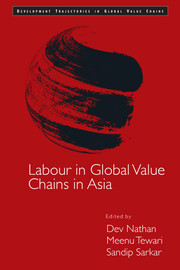Book contents
- Frontmatter
- Contents
- Figures
- Tables
- Foreword
- Preface
- Acknowledgements
- Introduction
- Captive Governance
- 2 Achieving Better Work for Apparel Workers in Asia
- 3 Improving Wages and Working Conditions in the Bangladesh Garment Sector: The Role of Horizontal and Vertical Relations
- 4 Bargaining in Garment GVCs: The Asia Floor Wage
- 5 Fresh Produce Markets, Standards, and Dynamics of Labour: Grapes in India
- 6 The ‘Zero-Fee’ Tour: Price Competition and Chain Downgrading in Chinese Tourism
- 7 Restricting Competition to Reduce Poverty: Impact of the Tourism Value Chain in an Upland Economy in China
- 8 Restructuring of Post-crisis GVCs: Tourism in Bali, Indonesia
- 9 Dynamics of Labour-intensive Clusters in China: Wage Costs and Moving Inland
- 10 Migrant Labour in Global Value Chains in Asia
- Modular Governance
- Relational Governance
- Conclusions
- Notes on Contributors
- Index
3 - Improving Wages and Working Conditions in the Bangladesh Garment Sector: The Role of Horizontal and Vertical Relations
from Captive Governance
Published online by Cambridge University Press: 23 July 2017
- Frontmatter
- Contents
- Figures
- Tables
- Foreword
- Preface
- Acknowledgements
- Introduction
- Captive Governance
- 2 Achieving Better Work for Apparel Workers in Asia
- 3 Improving Wages and Working Conditions in the Bangladesh Garment Sector: The Role of Horizontal and Vertical Relations
- 4 Bargaining in Garment GVCs: The Asia Floor Wage
- 5 Fresh Produce Markets, Standards, and Dynamics of Labour: Grapes in India
- 6 The ‘Zero-Fee’ Tour: Price Competition and Chain Downgrading in Chinese Tourism
- 7 Restricting Competition to Reduce Poverty: Impact of the Tourism Value Chain in an Upland Economy in China
- 8 Restructuring of Post-crisis GVCs: Tourism in Bali, Indonesia
- 9 Dynamics of Labour-intensive Clusters in China: Wage Costs and Moving Inland
- 10 Migrant Labour in Global Value Chains in Asia
- Modular Governance
- Relational Governance
- Conclusions
- Notes on Contributors
- Index
Summary
Introduction
In 2011, Bangladesh became the second largest garment exporter in the world, second only to China. Between 2006 and 2010, the minimum wage in the garment sector had increased by 33 per cent, which was considered as a major positive economic phenomenon. However, in 2012 and 2013, horrific incidents of fire and building collapse took the lives of thousands of workers. Accounting for these contradictory developments is the central purpose of this paper.
During the post-MFA (Multi-Fiber Arrangement) period, from 2005 onwards, the Bangladesh ready-made garment (RMG) industry grew at a rate of more than 25 per cent per year. However, since the arrival on the scene of garment exports from Bangladesh in the late 1970s, and even now, Bangladesh has often been held up as an example of the ‘race to the bottom’ in the global competition for contracts and jobs (as an example, Muhammad, 2011). In the 1990s, the prevalence of child labour in the garment factories of Bangladesh was the centre of European and US campaigns against ‘sweatshops’. Even after the elimination of child labour, the country's garment factories were still held up as examples of poor wages and working conditions. Several incidences of fire and building collapse have served only to confirm the unsafe working conditions of garment workers.
After a brief background section on the organizational structure of the Bangladeshi garment industry, this paper discusses changes in wages and working conditions over time. This discussion is based on a combination of primary field data collected through interviews with workers in factories and secondary data. Interviews were conducted with workers in factories both within export promotion zones (EPZs) and outside these.
The changes in wages and working conditions are then placed within the context of upgrading of Bangladeshi firms, moving from just cut-make-trim (CMT) to free-on-board (FOB) production. This is followed by a discussion of the links between the economic upgrading of firms and the social upgrading of workers. The various buyer initiatives for better compliance and their impacts are discussed next. Social upgrading, however, is not only a matter of buyer pressure but also, possibly more importantly, a result of workers’ struggles.
Information
- Type
- Chapter
- Information
- Labour in Global Value Chains in Asia , pp. 51 - 77Publisher: Cambridge University PressPrint publication year: 2016
Accessibility standard: Unknown
Why this information is here
This section outlines the accessibility features of this content - including support for screen readers, full keyboard navigation and high-contrast display options. This may not be relevant for you.Accessibility Information
- 9
- Cited by
